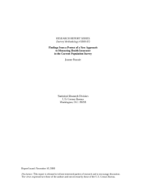
An official website of the United States government
Here’s how you know
Official websites use .gov
A .gov website belongs to an official government organization in the United States.
Secure .gov websites use HTTPS
A lock (
) or https:// means you’ve safely connected to the .gov website. Share sensitive information only on official, secure websites.
-
//
- Census.gov /
- Census Working Papers /
- Findings from Pretest of New Approach to Measuring Health Insurance
Findings from a Pretest of a New Approach to Measuring Health Insurance in the Current Population Survey
Findings from a Pretest of a New Approach to Measuring Health Insurance in the Current Population Survey
Abstract
This paper presents results from a pretest of an experimental questionnaire on health insurance coverage (the “Redesign”), developed to reduce measurement error in the Current Population Survey (CPS). Research has shown that some respondents ignore the calendar year reference period and instead report on their current status or their most recent spell of coverage, and that those with recent coverage are more likely to report accurately than those with coverage in the more distant past. Nevertheless, providing data on calendar year coverage is a goal of the CPS. Thus the Redesign takes a new approach to questions on time period of coverage, beginning by asking about current coverage status, and then asking about duration of coverage (at the month-level) during the past calendar year. The household-level CPS design has also been shown to risk underreporting for certain household members, and yet a person-level design lengthens the survey, inducing respondent fatigue and underreporting. The Redesign employs a hybrid approach. It begins by asking questions at the person-level and if a particular plan type is identified, questions are asked to determine whether other household members are also covered by that same plan. Subsequent people on the roster are then asked about by name, one at a time, and for those who had been reported as covered under a previously-reported plan, that coverage is simply verified and a question is asked to determine if they had any additional plans. A final problematic feature of the CPS is the way in which plan type is determined – through a series of eight fairly detailed questions on source of cove rage. The Redesign takes a different approach, first asking about any coverage at all, then identifying general source (job, government or some other way) and then following up with tailored questions to elicit the necessary detail. Pretest results (n=54) were generally positive, suggesting only minor changes to the questionnaire were needed, and paving the way for a large-scale split-ballot field test in March, 2010.
Others in Series
Working Paper
Working Paper
Working Paper
Share
Related Information
Some content on this site is available in several different electronic formats. Some of the files may require a plug-in or additional software to view.
 Yes
Yes
 No
NoComments or suggestions?


Top

